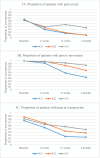Guided exercises with or without joint mobilization or no treatment in patients with subacromial pain syndrome: A clinical trial
- PMID: 33634829
- PMCID: PMC8814878
- DOI: 10.2340/16501977-2806
Guided exercises with or without joint mobilization or no treatment in patients with subacromial pain syndrome: A clinical trial
Abstract
Background: Graded resistance training is the recommended treatment for patients with subacromial pain syndrome. It is debated whether adding joint mobilization will improve the outcome. The aim of this study was to evaluate the clinical outcome of guided exercises with or without joint mobilization, compared with controls who did not receive any treatment.
Methods: A 3-armed controlled trial in a primary care setting. A total of 120 patients, with clinically diagnosed subacromial pain syndrome, were randomized into guided exercise groups with and without additional joint mobilization, and a control group that did not receive any treatment. Data were analysed at baseline, 6 weeks, 12 weeks and 6 months. Primary outcome was the Constant-Murley score, and secondary outcomes were pain and active range of motion.
Results: Shoulder function improved in all groups, as measured with the Constant-Murley score. At 12 weeks and 6 months the exercise groups improved significantly compared with the control group (p ≤ 0.05). Add-on joint mobilization resulted in decreased pain in active range of motion at 6 and 12 weeks compared with guided exercise or no treatment (p ≤ 0.05). Range of motion increased over time in all 3 groups.
Conclusion: In patients with subacromial pain syndrome guided exercises improved shoulder function compared with no treatment. Add-on joint mobilization decreased pain in the short-term compared with exercise alone or no treatment.
Keywords: Constant-Murley score; manual therapy; resistance training; shoulder pain.
Conflict of interest statement
Figures







Similar articles
-
Effectiveness of individualized physiotherapy on pain and functioning compared to a standard exercise protocol in patients presenting with clinical signs of subacromial impingement syndrome. A randomized controlled trial.BMC Musculoskelet Disord. 2010 Jun 9;11:114. doi: 10.1186/1471-2474-11-114. BMC Musculoskelet Disord. 2010. PMID: 20534140 Free PMC article. Clinical Trial.
-
Effect of specific exercise strategy on need for surgery in patients with subacromial impingement syndrome: randomised controlled study.BMJ. 2012 Feb 20;344:e787. doi: 10.1136/bmj.e787. BMJ. 2012. PMID: 22349588 Free PMC article. Clinical Trial.
-
Ultrasound-Guided Application of Percutaneous Electrolysis as an Adjunct to Exercise and Manual Therapy for Subacromial Pain Syndrome: A Randomized Clinical Trial.J Pain. 2018 Oct;19(10):1201-1210. doi: 10.1016/j.jpain.2018.04.017. Epub 2018 May 16. J Pain. 2018. PMID: 29777953 Clinical Trial.
-
Effects of eccentric exercise in patients with subacromial impingement syndrome: a systematic review and meta-analysis.BMC Musculoskelet Disord. 2019 Oct 14;20(1):446. doi: 10.1186/s12891-019-2796-5. BMC Musculoskelet Disord. 2019. PMID: 31610787 Free PMC article.
-
Subacromial impingement syndrome--effectiveness of physiotherapy and manual therapy.Br J Sports Med. 2014 Aug;48(16):1202-8. doi: 10.1136/bjsports-2012-091802. Epub 2013 Nov 11. Br J Sports Med. 2014. PMID: 24217037 Review.
Cited by
-
"Investigating the combined effects of scapular-focused training and Mulligan mobilization on shoulder impingement syndrome" a three-arm pilot randomized controlled trial.BMC Musculoskelet Disord. 2024 Nov 8;25(1):897. doi: 10.1186/s12891-024-07966-1. BMC Musculoskelet Disord. 2024. PMID: 39516846 Free PMC article. Clinical Trial.
-
High-energy injuries, combined ligamentous injuries, and joint incongruity as predictors of postoperative shoulder dysfunction in AC joint dislocation surgery.J Int Med Res. 2024 Nov;52(11):3000605241300084. doi: 10.1177/03000605241300084. J Int Med Res. 2024. PMID: 39612317 Free PMC article.
-
Effectiveness of Combined Program of Manual Therapy and Exercise Vs Exercise Only in Patients With Rotator Cuff-related Shoulder Pain: A Systematic Review and Meta-analysis.Sports Health. 2023 Sep-Oct;15(5):727-735. doi: 10.1177/19417381221136104. Epub 2022 Dec 14. Sports Health. 2023. PMID: 36517977 Free PMC article. Review.
-
New clinical decision tool to assist physical therapists with joint mobilization application to the pediatric population.J Man Manip Ther. 2024 Jun;32(3):304-309. doi: 10.1080/10669817.2024.2322213. Epub 2024 Mar 1. J Man Manip Ther. 2024. PMID: 38426695 Free PMC article. Review.
-
Biopsychosocial Approach in Identifying Risk Factors of Kinesiophobia in Persons with Subacromial Pain Syndrome and Developing a Clinical Prediction Tool.Indian J Orthop. 2022 Nov 25;57(1):124-136. doi: 10.1007/s43465-022-00781-7. eCollection 2023 Jan. Indian J Orthop. 2022. PMID: 36660479 Free PMC article.
References
-
- Breivik H, Collett B, Ventafridda V, Cohen R, Gallacher D. Survey of chronic pain in Europe: prevalence, impact on daily life, and treatment. Eur J Pain 2006; 10: 287–333. - PubMed
-
- Seitz AL, McClure PW, Finucane S, Boardman ND, 3rd, Michener LA. Mechanisms of rotator cuff tendinopathy: intrinsic, extrinsic, or both? Clin Biomech (Bristol, Avon) 2011; 26: 1–12. - PubMed
-
- Michener LA, Walsworth MK, Doukas WC, Murphy KP. Reliability and diagnostic accuracy of 5 physical examination tests and combination of tests for subacromial impingement. Arch Phys Med Rehabil 2009; 90: 1898–1903. - PubMed
Publication types
MeSH terms
LinkOut - more resources
Full Text Sources
Other Literature Sources

